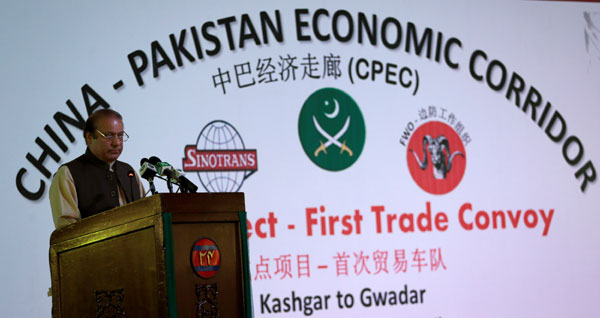Taking stock of power projects under CPEC
By Zamir Ahmed Awan | chinadaily.com.cn | Updated: 2018-09-05 11:04

China-Pakistan Economic Corridor was signed in 2013, but actual work started after the visit of President Xi Jinping in April 2015. Pakistan was facing severe shortage of electricity, and that resulted in several hours of power cuts on daily basis. The shortage hit the industrial sector hardest and affected industrial productivity. It resulted in reduction of export and earning of foreign exchange. One of the major reasons for poor economy of Pakistan was the shortage of electricity. Due to this, CPEC focused on power sector and most of projects initiated were in power generation and transmission. Here’s a brief look at power projects under CPEC;
The total portfolio of CPEC projects is $47.96 billion, namely $34.18 billion of energy projects (IPP financing mode), $4.18 billion concessional loan for transport and infrastructure projects, $8.21 billion loan for rail network, and $48 million grant for other projects, including Gwadar City Master Plan, etc.
As per progress report, Port Qasim electric power plants (2×660 MW, $1.91 billion-IPP) Karachi have been completed; SSRL Power-Thar Coal Block-1 2×660 MW (2000 million-IPP) and SSRL Coal Mine Thar Block-1, 6.8 metric tons per annum, are expected to be completed in 2019; Sachal Wind Power of 50MW in Sindh was completed in 2017; Hydro China Dawood Power Wind Power Project (50MW, $112.65 million-IPP) was completed in 2017; Jhimpir Wind Based Power (1×100 MW, $224 million-IPP) will be completed in 2018 and Matiari-Lahore Transmission Line ($1.50 billion-IPP, Sindh-Punjab) is expected to be completed in 2019.
The work on Oracle Thar Coal Based Power Plant Mine 2×660 MW ($1.30 billion-IPP) is underway while Engro Surface Mine in Block-11 of Yhar Coal, 3.8 metric tons per annum, ($1.47 billion-IPP) and Engro Thar Coal-fired Power Plant 4×330 MW (2×330 approved and 2×330 pending approval, $1.99 billion-IPP) projects are expected to operate at the end of this year. Work continues on 870 MW Suki Kinari Hydropower Project in Khyber Pakhtunkhwa at $1.95 billion with IPP mode and Commercial Operation Date (COD) of Hubco-Coal based Coastal(1×660 MW) in IPP mode in Baluchistan is expected to be completed in 2018/19.
Pakistan is blessed with huge natural resources like water for hydro-power, coal reserves of Thar are sufficient to meet the energy demand of the country for next 500 years. Abundance of solar energy - there are areas in Pakistan that have 17 hours of sunlight and almost 300 sunny days in a year. Wind energy is also a good source of renewable energy available in Pakistan. But due to lack of technology, investment and good planning, Pakistan has been suffering with shortage of electricity.
Till date 4,000MW of power have been added to the national grid under the CPEC. And a total of 17,000MW electricity would be generated under the CPEC energy projects in near future. As a result, the duration of power cuts has been reduced. It is expected that with the completion of on-going and in-pipeline projects, the nation will fulfill its electricity demand. It will contribute to socio-economic development of the country.
The price of electricity is Rs 8.5 per unit for imported coal and Rs 8 per unit for local coal and Rs 9.5 for LNG fuel. And the price of electricity has been fixed at the rate of Rs 5 per unit on solar after bidding process.
The government of Pakistan is paying full attention on security of CPEC, Chinese nationals and Chinese work-sites. For this purpose a total of 9,929 troops and 4,502 civilians have been deployed to provide security. There are a total of 10,000 Chinese and 65,000 Pakistanis working on various CPEC projects. A total of eight investors, four each from Pakistan and China, have signed a memorandum of understanding in Gwadar Free Zone. The biggest hurdle in the development of Gwadar is shortage of water and electricity. Currently only 300,000 gallons of water is being supplied to Gwadar city per day against 6 million gallons demand. Appropriate measures needed to be taken on priority.
The new government in Pakistan is well-aware of electricity shortage and conscious about the cost of electricity. I think Chinese entrepreneurs may focus on power sector and allied industry. They may come forward and collaborate with the newly established government in Pakistan and may extend their cooperation to meet the agenda of new government that is “to provide abundance of electricity at affordable cost”. There exists huge scope of opportunities in power sector of Pakistan.
The author is Sinologist (ex-Diplomate), Non-Resident Fellow of CCG (Center for China and Globalization), National University of Sciences and Technology (NUST), Islamabad, Pakistan.
























